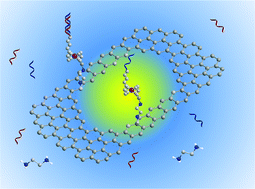Large area graphene nanomesh: an artificial platform for edge-electrochemical biosensing at the sub-attomolar level†
Abstract
Recent advances in large area graphene growth have led to tremendous applications in a variety of areas. The graphene nanomesh with its tunable band-gap is of great interest for both fundamental research, to explore the effect of edges on both the 2D electrical conduction and its electrochemical behavior, and applications such as nanoelectronic devices or highly sensitive biosensors. Here, we report on the fabrication of a large surface graphene nanomesh by nanoimprint lithography (NIL) to produce controlled artificial edges. The electrochemical response of this high quality single graphene layer imprinted nanomesh shows an enhancement in capacitance associated with faster electron transfer which can be attributed to the high density of edges. The electrochemical performances of this nanomesh graphene platform have been also studied for label-free DNA detection from Hepatitis C virus as a model. We demonstrate that such a nanomesh platform allows direct detection at the sub-attomolar level with more than 90% of molecules located on the imprinted artificial edges. Such a graphene nanomesh electrode will find useful future applications in the field of biosensing.


 Please wait while we load your content...
Please wait while we load your content...